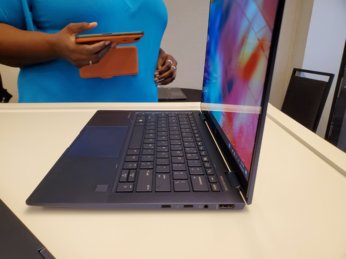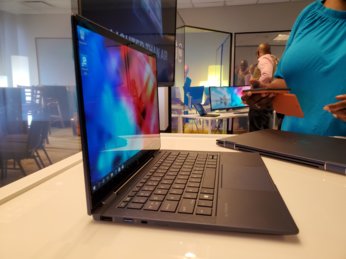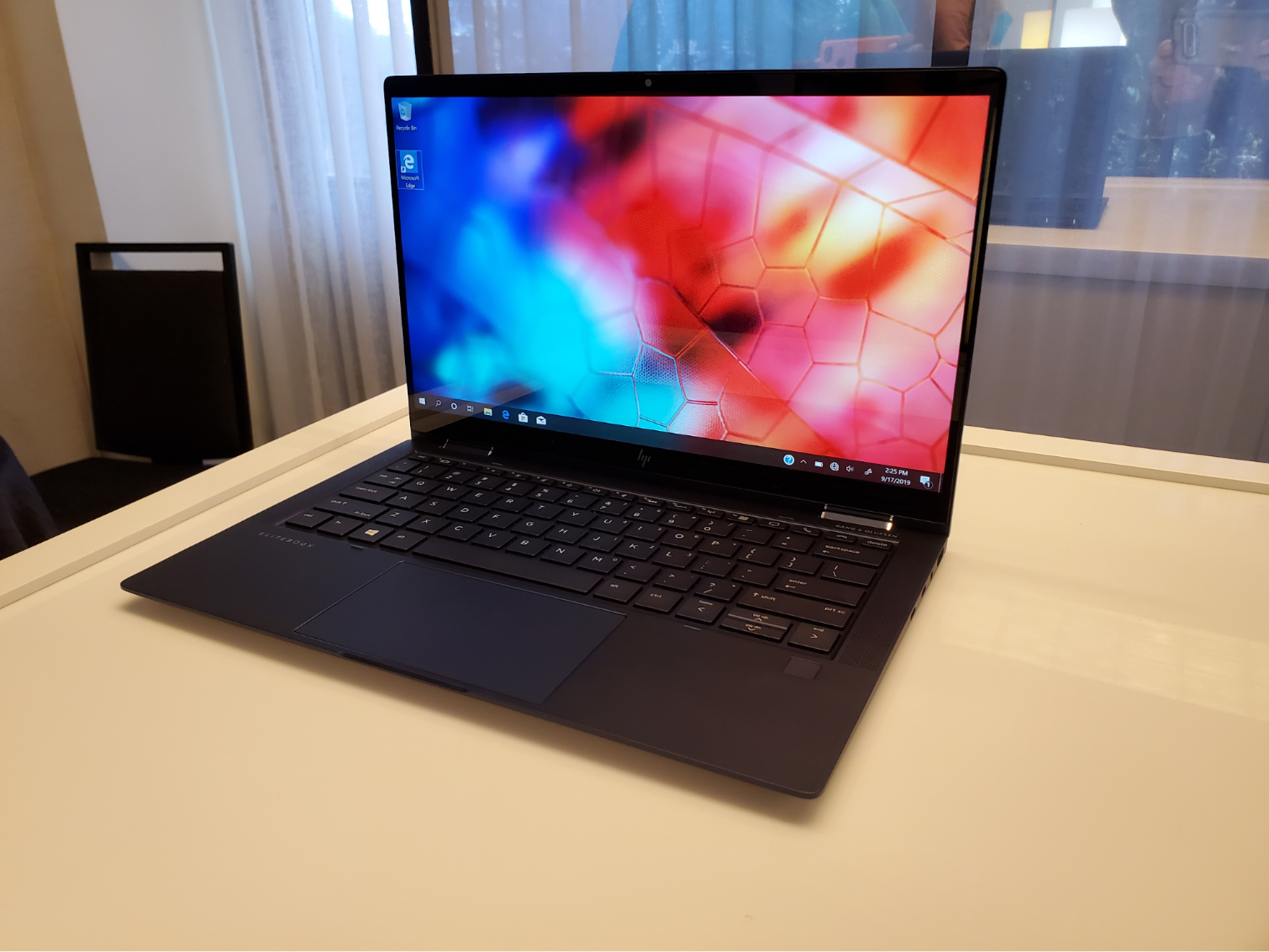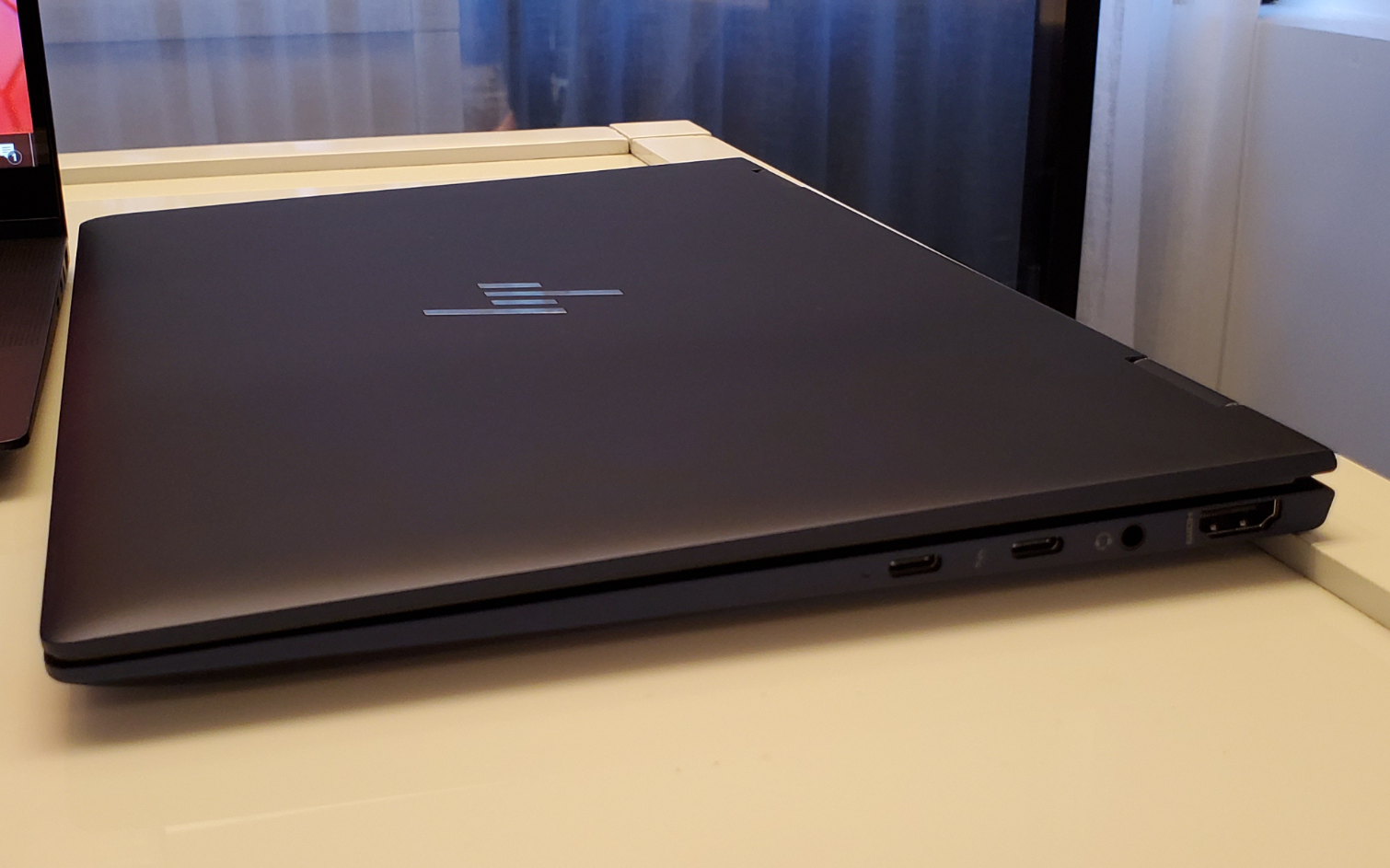Hands on With HP's Elite Dragonfly: A New Bar for Premium Ultraportables?
Buzz off, XPS 13. The Elite Dragonfly convertible might be the new premium portable to beat. At the very least, it's the first business-focused laptop I've used in a long time that makes me want to leave my personal ultrabook at home. It’s also yet another addition to the growing list of Project Athena laptops.
HP's just-announced Elite Dragonfly is an under-1kg (2.2 pound) 13-inch fold-over with full-size USB-A and HDMI ports (one of each), plus two USB-C /Thunderbolt 3 ports. It also sports an attractive, sturdy “dragonfly blue” iridescent CNC-aluminum shell (which unfortunately looks more brown/grey under the lighting provided) with a finish that’s treated to resist fingerprints. It also has one of the best keyboards I’ve used on any ultraportable, screen options aplenty, and a promised battery life of 16 hours on the base model, or up to 24.5 hours if you opt for the extended battery model.
While HP is aiming the Elite Dragonfly at customers whose work life blends with the rest of their life (hi there, basically everyone in 2019), it's a business laptop first. That means it packs Intel’s vPro tech (for security and remote maintenance), HP’s third-gen Sure View privacy screen as an option, and the company’s Sure Sense, which HP says uses machine learning to help prevent against unknown viruses and other forms of advanced malware.
In other words, HP is placing lots of importance on security with the Dragonfly, which is great even all the headlines about vulnerabilities and breaches over the last few years. But the need for vPro means your CPU options with this laptop are stuck in the quad-core Intel 8th Gen realm, rather than newer six-core 10th Gen CPUs (which aren’t available with vPro yet).
After getting some hands-on time with HP's Elite Dragonfly at a press event here in New York City yesterday, the slightly aged CPU limitations seem to be the primary downside.


Well the CPUs and the price. Starting at $1549 with just 8GB of RAM and a Core i5, this Elite laptop owns its namesake. Still, that's not exactly astronomical for a premium business laptop – especially one that I’d happily make my primary PC. Please don't tell my Ryzen gaming rig I said that.
Some of the other finer points of the Elite Dragonfly: The base model's 1080p touch display looks quite good, and is rated to 400 nits. But you can also opt for a 4K HDR 400 panel, or a Sure View screen with a super-bright 1,000-nit screen. Note the latter option is so bright in part because HP's Sure View screen privacy tech tends to massively cut brightness when switched on.
Get Tom's Hardware's best news and in-depth reviews, straight to your inbox.
The keyboard is also a key selling point for the Elite Dragonfly—or it should be. I’m reserving full judgement for when I get to spend more than a few minutes typing on it. But in my brief hands-on, I was impressed with both the amount of travel and the tactile feel of the keys—which use rubber domes. I’m not tossing my mechanical desktop keyboard anytime soon, but I feel like the keyboard HP is offering here can compete favorably with the best ultrabook keyboards in the business—including Lenovo's ThinkPad X1 Carbon, even though the Carbon’s keys feel distinctly different.
Oh, and HP claims to have factored the sound of the keyboard (which is actually pretty quiet) into the noise-canceling algorithm of the microphones. So your colleagues shouldn’t here you typing away (and pretending to pay rapt attention) while they talk.
Connectivity is also important for both work and play, so HP has included next-gen Wi-Fi 6 (802.11ax), as well as optional 4x4 cellular LTE connectivity in its Elite Dragonfly. And for those who prefer a pen to the keyboard, the laptop is designed to work with HP's Active Pen G3, which stows in a newly designed leather sleeve to help keep you from using it.
As for the full list of specs, as a business device from HP, there are five CPUs, eight SSD options (which sadly start with a 128GB SATA drive), three screen options. Plus there’s the standard 38 Wh battery, or a 56 Wh option. And HP says fast charging means you’ll be able to charge the Dragonfly to 50% in just a half hour.
Part of what makes the Elite Dragonfly stand out (other than its quietly badass name) is that HP isn’t trying to introduce anything groundbreakingly new here. The company told us its internal research shows that people are coming back to their PCs as the device you go to for focused work or play. And in my experience, the traditional clamshell design is still the best for productivity (sorry Surface Pro), while a fold-over hinge has proven great for media consumption.
So instead of trying to reinvent what’s already a great form factor, the company has refined it – seemingly to an extreme. Again, I haven’t spent days or weeks with the Dragonfly yet, but from the moment I held it in my hand, it was clear this is indeed an elite portable PC – maybe the best there is. To my mind that was a crown held by Dell’s XPS 13 for years. But now I’m not so sure.
I love the Dragonfly’s blue shell (even though Asus has been pushing a similar color on some of its ultrabooks for years). The keyboard feels great at first blush. The whole package feels very rigid -- HP says the design was put through 19 MIL-STD 810G tests and a total of 120 thousand hours of HP testing procedures. And even the base-model screen looks great, thanks in part to bezels that are thin enough to look modern and sleek, while still leaving room for the 720p IR Webcam up top (Windows Hello support is included, along with a fingerprint reader) where it belongs.
I’m eager to see how HP’s battery life claims hold up in real life (and in our battery test), and I’m hoping that the four Bang & Olufsen-branded speakers (which I didn’t get to listen to) live up to their name. But if they do, and the keyboard turns out to be as good as it felt in my few minutes of typing, HP might have a big hit on its hands. At the very least, Dell and Lenovo have stiffer competition in the premium/business ultraportable market than they have in years.
I’d just like to see some newer CPU options given the Elite Dragonfly’s high price. That’s not HP’s fault, as Intel hasn’t released 10th Generation vPro CPUs yet. But if I were a customer or an IT professional considering adding this laptop to my loadout, I might hold out for some newer processor choices.
Image Credits: Tom's Hardware
MORE: Best Gaming Laptops
MORE: Laptop Reviews
MORE: All Laptop Content
After a rough start with the Mattel Aquarius as a child, Matt built his first PC in the late 1990s and ventured into mild PC modding in the early 2000s. He’s spent the last 15 years covering emerging technology for Smithsonian, Popular Science, and Consumer Reports, while testing components and PCs for Computer Shopper, PCMag and Digital Trends.
-
nitrium What differentiates a "premium/business" laptop with a regular cheap ultra portable? Not RAM, CPU, battery or screen specs, that much is certain. Surely it must be more than just the "HP brand" and a fingerprint reader???Reply -
warezme At $1549 the only thing premium is the price because the specs of 8GB of RAM, an Intel i5 and only a 1080p screen from 1990 don't. If you were really serious about security it wouldn't even be an intel process but an AMD. Hard pass on this mobile disaster.Reply -
cryoburner Reply
I think it mostly just comes down to build quality, like a shell made out of a solid block of aluminum alloy, for example, as opposed to plastic for the budget models. That can potentially result in improved durability, and the better heat conductivity of such materials may also allow the same hardware to be packed into a more compact form-factor. Of course, it also results in many of these devices being more or less unserviceable on the hardware side of things. You may also see better battery life, better keyboard and screen quality, and so on, that may not be obvious from the basic specs. From a value standpoint, the cheap ultraportable will likely be the better option, but these "premium" options are there for those willing to spend a lot more for something slightly better.nitrium said:What differentiates a "premium/business" laptop with a regular cheap ultra portable? Not RAM, CPU, battery or screen specs, that much is certain. Surely it must be more than just the "HP brand" and a fingerprint reader???
Who had 1080p screens in 1990? 640x480 would have been considered the norm for new computers then. : Pwarezme said:At $1549 the only thing premium is the price because the specs of 8GB of RAM, an Intel i5 and only a 1080p screen from 1990 don't.
While 1080p might not exactly be considered a cutting-edge resolution now, at 13.3", the pixel density is comparable to having 4K on a 27" display. The 4K option actually seems quite overkill at this screen size. -
Giroro Replynitrium said:What differentiates a "premium/business" laptop with a regular cheap ultra portable? Not RAM, CPU, battery or screen specs, that much is certain. Surely it must be more than just the "HP brand" and a fingerprint reader???
As far as I know, it is the CPU actually that puts it into the business category, specifically because it supports vPro.
The premium category is essentially "Increase profit margins by putting using a case that feels expensive", so basically anything inspired by Apple's business strategy... or what their strategy used to be before the competition blew past their hardware design and they started throwing subscriptions services at the wall to see what sticks. I was looking at a MacBook air yesterday and was pretty surprised to see how much thicker it felt compared to Costco's ultrabooks. -
DavidC1 Replywarezme said:At $1549 the only thing premium is the price because the specs of 8GB of RAM, an Intel i5 and only a 1080p screen from 1990 don't. If you were really serious about security it wouldn't even be an intel process but an AMD. Hard pass on this mobile disaster.
It's a convertible and its super light. If you want it to be a convertible, the lighter the better, as it makes the Tablet function more useful and not just a feature to check off.
FHD screens are also superior to 4K displays in such laptops, because it also uses much less power. The 500-nit display on this device is also a 1W-display, the same thing Intel demonstrated more than a year ago. So that's further power savings. 4K displays also need to upscale everything and will cause slight blurriness in many applications that aren't running at 4K.
You can't have all the features and expect it to cost less. It just doesn't work.
The only issue is the use of Whiskeylake. Let's say by spring of 2021 we get Tigerlake on this thing and it'll be perfect.






